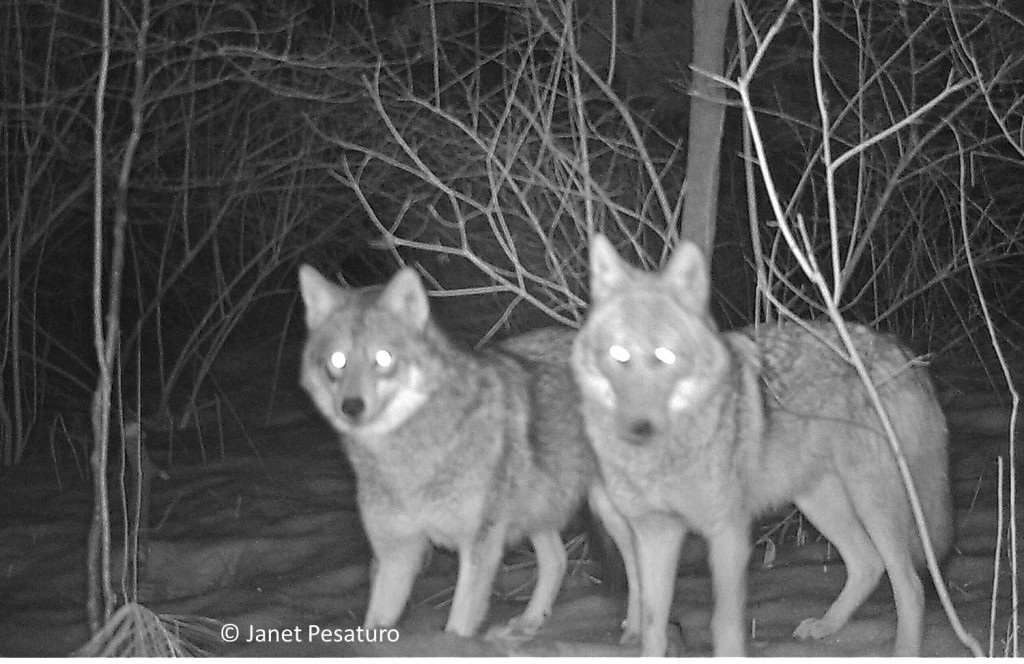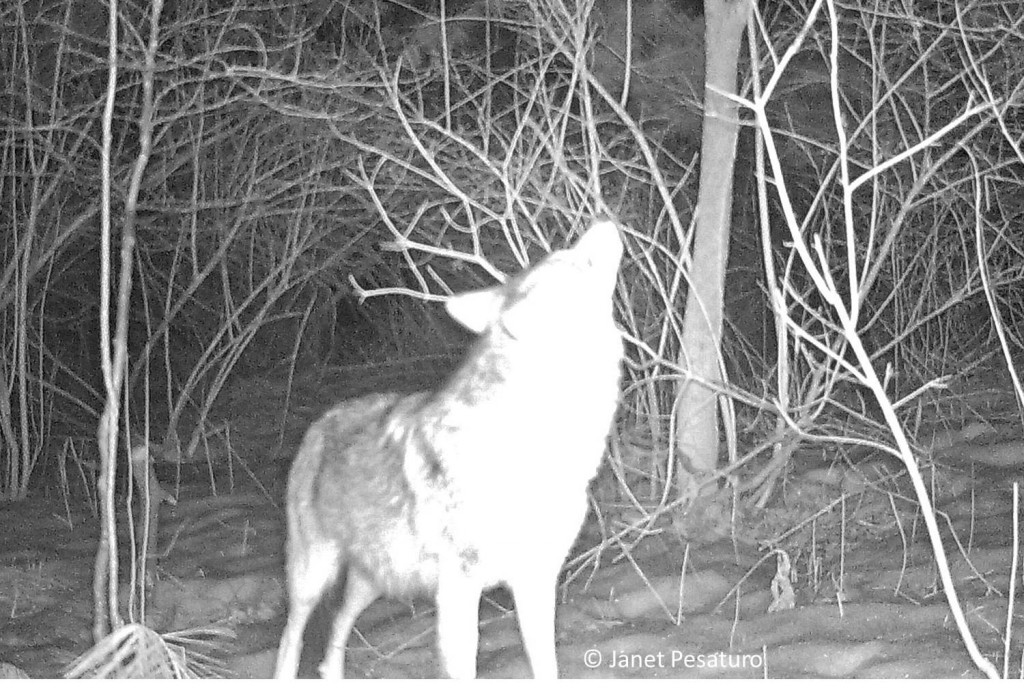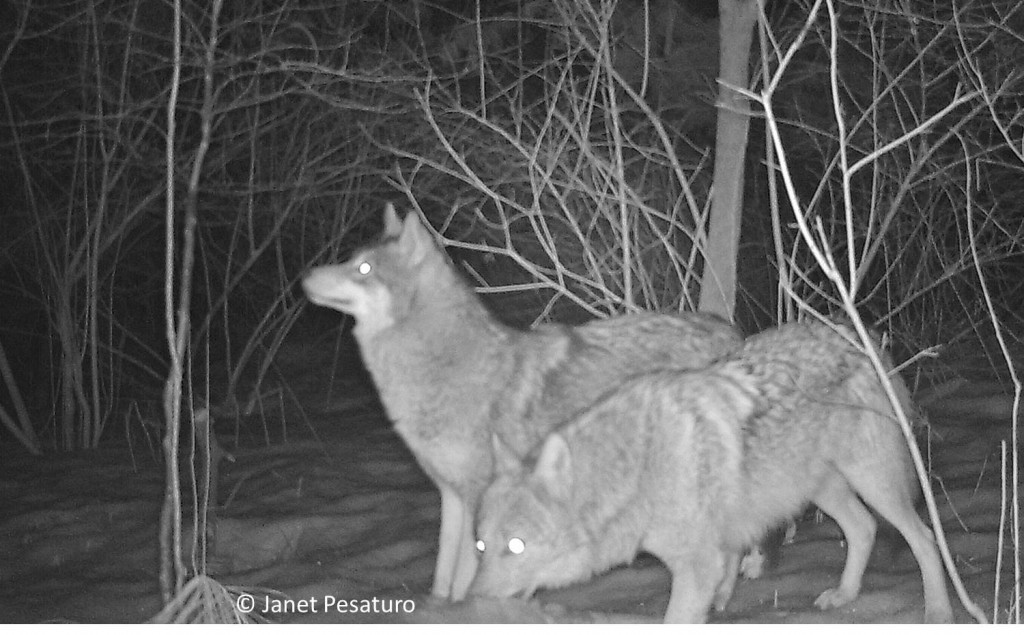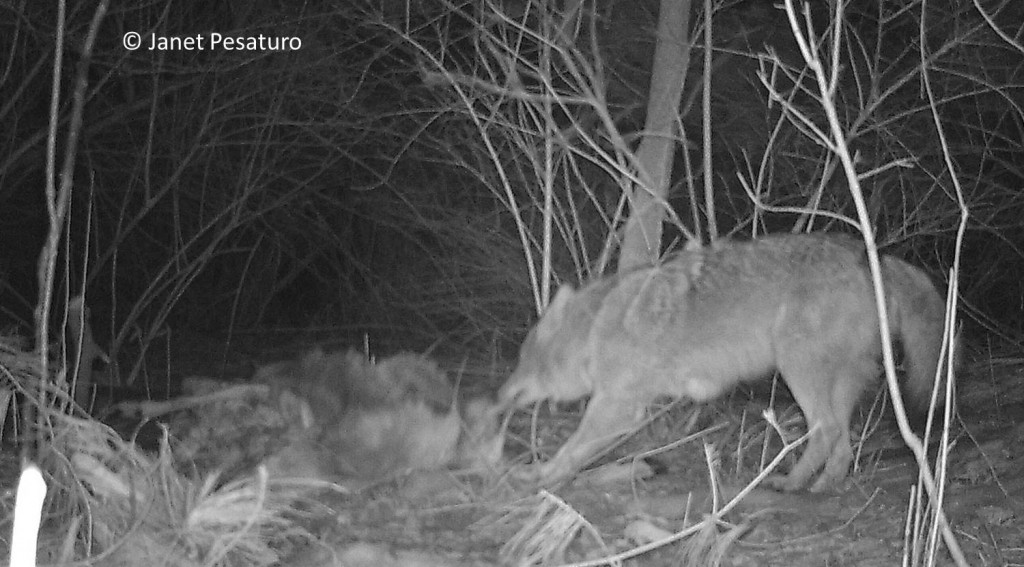
Appreciating the eastern coyote. These two coyotoes were among the cast of characters who visited my baited camera trap.
These clever predators can be quite a problem for both livestock and pet owners, and I’m sure some readers will find this post downright bizarre. But appreciating the eastern coyote is one of the benefits of preventing rather than reacting to attacks by wildlife. In fact, I was delighted to get a glimpse into the life of this striking pair, through my camera trap. I am fascinated with this creature’s wariness, persistence, and social behavior, as well as the ongoing saga of its arrival in eastern North America.
Where did the eastern coyote come from?
The story of the eastern coyote’s emergence is one of evolution in action. Genetic studies show that it is a mix of western coyote and eastern wolf, but with more DNA from its western coyote heritage. Evidently, the western coyote expanded its range eastward as humans cleared forest for agriculture and decimated the eastern wolf population. The rare remaining wolf probably mated with a western coyote when another wolf was nowhere to be found.

Eastern coyote at deer carcass. When only one appeared alone, it called for the other one, before beginning to feed.
The product of that migration and hybridization, the”eastern coyote”, is a wild canid (member of the dog family) intermediate in size and social behavior. It is larger (35-50 lbs.) than the western coyote (25-30 lbs.), and smaller than the eastern wolf (about 70 lbs.). Like the wolf, it’s more likely to live in small packs and cooperatively hunt larger prey. But, unlike the wolf, the eastern coyote can survive on small prey, which abounds in fragmented suburban and agricultural landscapes.
The intermediate appearance is noticeable in my photos, if you compare them to the western coyote here, and the eastern wolf here. The western coyote has a slender, delicate build, and rather long ears. The wolf has short ears and a broader build. The eastern coyotes in my photos have ears of intermediate length, but I think the animals look about as broad and robust as wolves.

I’ve read that coyotes do not howl to call each other to share food, but photos from my trail camera might suggest otherwise. Sometimes when only one showed up, it appeared to howl or bark. I’m not sure why it would vocalize before eating, if not to call its mate.
Huh? Appreciating the eastern coyote? Isn’t it an invasive species?
Given this history of range expansion and hybridization, some people label the eastern coyote a non-native, invasive species. For many people, that label justifies persecution of this animal whose taste for domestic animals and game species can evoke fury even in dedicated wildlife enthusiasts. And people do kill them, in great numbers. In fact, coyote Biologist Jonathan Way writes that it has been quite difficult to get long term data on coyote behavior, simply because people keep killing his radio collared study subjects. You can read his account in his engaging and compelling (and sometimes humorous) book: Suburban Howls: Tracking the Eastern Coyote in Urban Massachusetts
But I digress. That’s a huge and controversial topic in and of itself…

Beautiful pair of eastern coyotes. When together at the deer carcass, one seemed to stay on watch while the other ate.
What about this idea that the eastern coyote is a non-native, invasive species? That’s not an easy question to answer. Biologists define native species as those which evolved within the region, or arrived and established themselves without human assistance. That doesn’t help us too much, because, in my opinion, one could argue either way.
The sticking point is that human-induced landscape changes probably helped them move eastward. However, other human activity (namely relentless, direct killing) likely hindered them. So the coyote got here both because of, and in spite of, human activity. Finally, one could argue that even if it was encouraged by human induced landscape changes, the eastern coyote is merely reclaiming a pre-existing, wild canid niche, occupied by wolves before humans devastated them. In a sense, the eastern coyote is Nature’s way of returning wolf genes to the east, packaged in a smaller animal that can thrive within the highly fragmented, human dominated landscape.

The deer carcass was frozen to the ground for days, but here the persistent canid finally succeeded in dragging it to a secluded spot, about 20 feet away. I then moved the camera to the new site of the carcass, but the coyotes dragged it away again.
The eastern coyote is an evolving entity, possibly on its way to becoming a new species, and perhaps already deserving of that distinction. Like all species, it emerged as a result of selection pressures and opportunities within the changing environment. Indeed, the eastern coyote’s story exemplifies evolution, the very process which allows for the continuation of life within the ever changing conditions on Earth. I find it hard to condemn the product of such a beautiful process.
Additional Sources of information:
- Coyote, (Schadler)
- Project Coyote
- Genetic Characterization of Eastern “Coyotes” in Eastern Massachusetts (Way, et al.)
How do you feel about coyotes? Fear, anger, hatred? Admiration, tolerance, love? Or ambivalence?
Shared on: Homestead Barn Hop #158, Heritage Homesteaders Hop #10, Thank Goodness it’s Monday #69, Backyard Farming Connection #79, Down Home Blog Hop #86, HomeAcre Hop #69, Wildcrafting Wednesday #136, From the Farm Blog Hop, Simply Natural Saturdays, Mountain Woman Rendezvous #45, Simple Life Sunday #17












Hi Janet,
I subscribed to your blog about two months ago. Love it. I live in south central Nebr. right along the South Loup River on 3 acres. I am greatly in favor of leaving nature animal, including predators–alone. I am writing a book about mountain lions returning to Nebr.
Thanks again for your posts.
Hi Valerie,
A book about mtn lions returning to Nebraska sounds like a noble pursuit! Just peeked, and see you have a great blog yourself, including several books. I hope to be that accomplished someday. Thanks for your kind comment; I am thrilled that you enjoy my blog!
A most excellant article, I enjoyed reading it very much.
I give you kuddos for writing it due to its possible controversial nature. But I will go out on a controversial limb here with you and state that I personally am glad to see the species resurface and I pray they will continue to thrive.
I find it ironic….hugely so, that we gripe and moan and complain about immigration and people coming into our country illegally and taking over….well, isnt that what we did to this country way back when. We came in, took it from the indians and wildlife that called this country their home….we were the immigrants, we took over. Perhaps we should remember that….put proper perspective on that feeling and allow the coyote a place in this country that he used to roam freely in. Thats my limb and I’m sticking to it! Again, a most excellent point and read…thank you!
Many thanks, Kat. Totally agree with your point about us, the immigrants, invading North America and taking it away from Native Ams…and wolves, cougars, etc. You are so right, this is a controversial topic. I tried to be fair and see both sides, but of course wanted to express my own opinion as well. I am truly surprised that all the comments thus far (four) have been positive. However, I couldn’t help but notice that I lost a few subscribers immediately after publishing this post, so I suspect that many silent readers disagree strongly.
Great post–I really like your argument for seeing the eastern coyote as an evolving species that belongs here. I’m saddened by the wanton killing of them in my area, since preventive measures can protect flocks of chickens pretty easily, and because the killing of an adult coyote may cause further suffering to its young.
It’s amazing how wolf-like they look. I’ve never seen any of the coyotes that live near us, but I track them and hear their calls and songs. There’s one living nearby (I call him Big Boy) who clearly expresses his wolf genes more than the others–his tracks are almost twice the size of the other coyote tracks in this area (and he’s definitely not a dog, based on observations of his activity and the pattern of his toes).
Love your blog!
Thanks, Kellyann! Just clicked on your name, and see that you have a great blog yourself! You are so luck to live in VT – my favorite place in the world. Very interesting to learn of those huge coyote tracks. It may well be one with a lineage of more recent breeding with a wolf. Don’t quote me on this, because it has been a few years since I read the book, but I believe that in Suburban Howls, Jon Way describes one of his study subjects – a female – that weighed about 70 lbs. So there are occasional huge “coyotes” and I would imagine that their DNA is more than a few percent wolf!
Thanks for stopping by!
70 lbs. is one huge coyote. And a female, too–maybe I should be calling the large one “Big Girl” instead!
Really great article, very interesting to see how nature finds a way. What are the concerns and protections one should take if they have eastern coyotes in their area.
Great question, Evan, and a topic I plan to take up in future posts. In brief, you should know that coyotes usually avoid people, and attacks on people are extremely rare, so you don’t need to worry about letting kids play outdoors. Keep pets and livestock safe by not letting them roam free, unless you are willing to accept loss. Make trash, pet food, and any other potential food source inaccessible to wildlife. Keep livestock locked up at night. During day, use proper fencing, guard animals, and a general set up and routine which deter predators. Some of that is vague because it is a big topic, which again, I plan to cover in the future. Thanks!
Thanks
Hi Janet:
I really enjoyed reading your post, even though I take an opposite position entirely. I appreciate your point of view that the Coyote represents “continuation of life within the ever changing conditions on Earth.”
The reason I ultimately disagree is that I feel that POV necessarily discounts people and their interests. Of course, human activity completely dominates the natural environment at this point. It is our values (“humane” ones hopefully) and actions that ultimately determine which species thrive and which decline.
Part of our lives and values is our love for domestic animals. I think it’s just as natural for us to appreciate those bonds, as it is to appreciate the coyote. So, I’d argue it’s more humanist to take steps to limit coyote’s–it’s accepting ourselves as part of the natural world and promoting healthy human values.
Best, Jon
Thanks for sharing your comment, Jon. I just want to say that coexisting with coyotes and other predators does not necessarily discount people and their interests. I did not get into it in this post, but there are ways to protect pets and livestock without killing predators. I think that nonlethal protective measures still accept ourselves as part of the natural world, but require a different mindset and a lot of forethought. There are some excellent sources of information on wildlife friendly farming, dealing with all kinds of livestock and predators, and that’s a topic I hope to cover in a future post.
This is a very interesting issue.
Intellectually I totally support Janet’s point of view. Having said that, no way I want coyotes living near my home. My daughter would be terrified and I would be worried about someone getting hurt.
This is why I’m conflicted.
Evan, I am sure they already live near your home. This is a common species which does well in suburbs (this is well documented), and knowing where you live and the lay of the land in your neighborhood, I feel confident saying they live there. And yet they leave people alone. The risk is with small pets and livestock. Attacks on people are exceedingly rare.
Don’t tell Alta
We have wild Turkey and Deer so I guess it make sense. Never seen one.
LOL, my lips are sealed!
Loved it but all things in moderation. In our area the coyote is becoming over populated and becoming a huge problem for the local farmers. Therefor the local police station is paying $25 for each coyote until the population is decrease to a save level.
I’m glad you enjoyed the post, Emma. One concern I have about these bounties is that recent studies are showing that predator hunting actually reduces tolerance and increases people’s desire to kill them. It’s not like hunting game animals, which creates incentive for conservation, because people see the species as a food resource. And, if there is one thing we need more of in this increasingly crowded world, it’s tolerance for wildlife, including predators. There are effective, nonlethal protective measures that can be employed for livestock, and as I said in a reply to another comment, I plan to cover that in a future post. Thanks for your comment!
I love having the coyotes nearby. Their howls make me tingle with the excitement of life! Coyotes are a welcome neighbor since wolves, bears, and other large predators have been extirpated from the area. Something has to help keep our ecosystems in balance! I’m thankful to coyotes for filling that niche and helping to keep down the populations of small mammals (mice, voles, rabbits, etc.).
If people are informed of how to live with coyotes, we can coexist quite well. It’s pretty easy to bring your small animals in at night, and coyotes are generally very wary of us!
(I say all this after having studied the coyotes in the Cleveland area for several years… 😉 )
P.S. Killing coyotes is fruitless. More coyotes will just come in to fill the void. For example, if you kill a coyote that has established a large home range, 2 or 3 other coyotes can come in to make up for that newly opened territory. Learning to coexist makes the most sense.
You are absolutely right! And quite honestly, I am surprised that so few people seem aware of the importance of predators and the ineffectiveness of lethal control. At first I was thinking of just one more post on predators, explaining our own coexistence strategy, but I now see that a post devoted solely to the reasons for coexistence and another on strategies and resources for coexistence used with different livestock breeds. It’s a big topic that warrants a lot more coverage than what I initially had in mind.
Wow! I finally found you! I have become so disillusioned-No, Sick! And Tired! of running across homesteading blogs where both blogger and commentors go on and on about the evils of opossums and raccoons and hawks, and most any of our native wildlife. They leave me bewildered that seeking a more natural way of life leads them to this skewed vision that their chicken has more intrinsic value than a fox. Or more right to be there, or less right to eat. My last disgusting read was the lady who took her poor sick chicken to the vet and came home to find -to her delight- that the dog had killed three squirrels. We’re all doing the same thing on this earth, just trying to scratch out a living. I don’t mean to rant, I seemed helpless to stop :-). I really just wanted to thank you for your thoughtful posts on wildlife, and your courage to say it in this venue, and how much I’m looking forward to reading through your entire site.
Amen! I agree!!
Aw, thank you both so much! I totally understand you’re feeling disillusioned and sick and tired, but delighted to hear from people like you, who value wildlife, even when create difficult challenges for us!
Pingback: 10 Myths About Wild Predators - One Acre Farm
Pingback: Hunting Ethically with Mind, Body and Soul: An Interview - One Acre Farm
Pingback: Poultry Predator Identification: A Guide to Tracks and Sign - One Acre Farm
I live in a neighborhood in a fenced in yard that has a security fence six feet tall. At the left back corner a giant drainage pipe attached to a huge ditch runs the length of the back of my yard. My yard is just under a half acre in a cul de sac. Coyotes have built a den in the sewer and come in my yard every night and I have animals ducks,chickens and rabbits.in the past two months the coyotes have killed and eaten,taken off with and left carcasses for the next night three ducks two rabbits and twenty one chickens. I am afraid to go in the back yard or front yard for that matter. Now I found two areas where they’re leaving scat. I’m not a fan of them. I have three chickens and nine rabbits left. I hope they don’t come back when it is done. I believe that my yard is dinner time to them. Not a fan of the cute cuddly doggy relatives at all. They’ve attacked several people around my area.
I am sorry for your losses but you need to secure your livestock. From your description I’m not exactly sure how they are reaching your animals, but it is certainly possible to build coyote proof pens and coops. I used to raise chickens and rabbits in an area with a high coyote population and never lost a single animal to coyotes. Search this site for posts on predator proofing chicken coops. There are many other online articles dealing with protecting livestock from wild predators, too. In terms of the aggressiveness, it’s quite possible that you are inadvertently encouraging that by unintentionally feeding them (by not securing livestock). Coyotes that feed on human food sources lose their fear of people.
Urban and suburban coyotes are becoming so tame and habituated to people that they stalk toddler children in their own yards. My brother in law ran one off that was stalking his little child. Enough is enough!
Coyote attacks on people (usually children) are still very rare but you make a good point that they have been increasing as coyotes lose their fear of people. And the reason they are losing their fear of people is that people feed them, both intentionally and unintentionally. So I agree that enough is enough, in terms of stupid human behavior. Here are some suggestions on avoiding conflicts with coyotes, from Urban Coyote Research Project. https://urbancoyoteresearch.com/coyote-info/how-avoid-conflicts-coyotes